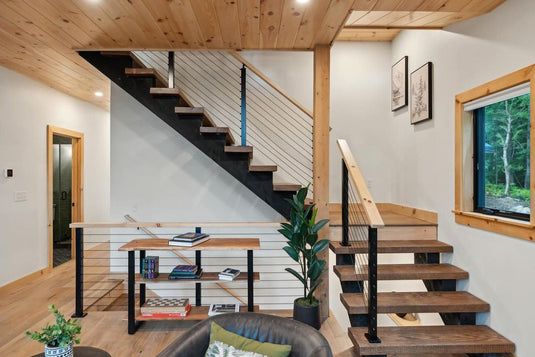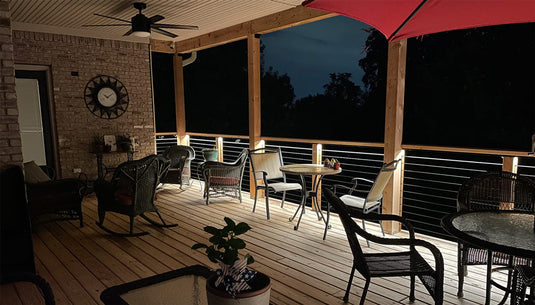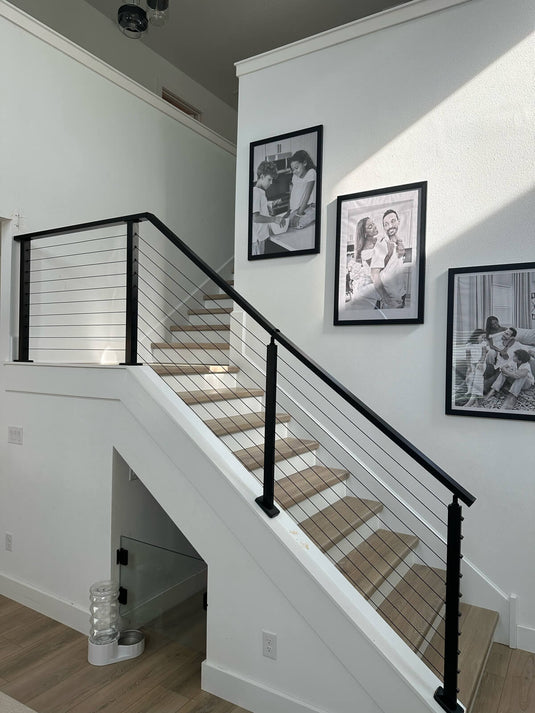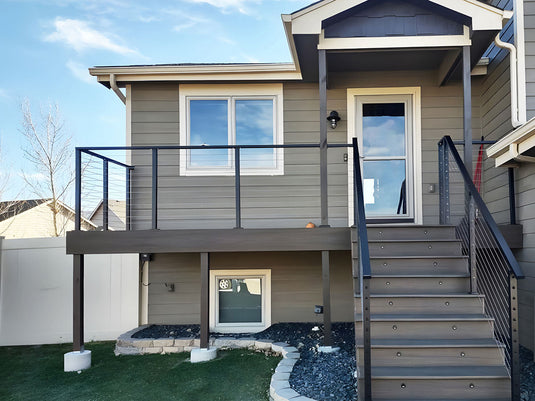TABLE OF CONTENTS
Designing with Cable Rail: Key Considerations for a Modern Aesthetic
Sleek, minimalist, and almost invisible—a cable rail system is the go-to choice for homeowners who want to add a modern touch to their decks and stairways without sacrificing the view. But achieving that clean, high-end look requires more than just picking parts out of a catalog. A great cable rail design is a thoughtful blend of materials, orientation, and details. This guide will walk you through the key considerations to help you design a system that is not only beautiful but also safe and durable.
What Defines the Cable Rail Design Aesthetic?
The contemporary attractiveness of a cable rail system lies in what it will not do. Instead of obscuring the view with thick wood or vinyl pickets, the slender stainless steel cables appear to disappear, giving the impression of openness and clarity. The neat design lets your view become the focal point, whether it happens to be a rolling landscape or simply your backyard garden.
The secret to a beautiful cable rail design is simplicity of line and minimal geometry. The posts, the top rail, and even the cables themselves all combine to form a look that is architectural without being obtrusive. It's a look that will enhance modern, contemporary, and even rustic-industrial home styles by introducing an element of high-style simplicity.
What Materials Should You Choose for Your Posts?
The posts are the structural backbone of your railing system, and the material you choose will have the biggest impact on the overall look and maintenance requirements.
Metal Posts (Aluminum & Stainless Steel)
For the ultimate modern and minimalist look, metal posts are the top choice. Aluminum posts are lightweight, rust-proof, and often come in a durable powder-coated finish. Stainless steel posts offer a similar sleek profile with a premium, industrial feel. Both options provide the slimmest possible profile, maximizing your view.

Wood Posts
If you want to soften the modern look or blend the railing with a more traditional deck, wood posts are a fantastic option. Materials like cedar, redwood, or pressure-treated pine can add a natural warmth and texture. A popular cable rail design trend is to pair thick, substantial wood posts with a sleek metal top rail, creating a beautiful rustic-modern contrast. Keep in mind that wood will require more maintenance, like regular staining or sealing, to protect it from the elements.

How Do You Select the Right Top Rail?
The topmost rail caps your posts and is both a safety requirement and a major design element. Its shape and material can greatly impact the appearance and feel of your railing.
Flat, Rectangular Profiles
A flat rectangular top rail, often in steel or aluminum, provides the best, most architectural appearance. It forms a clean, uninterrupted line that enhances the modern aesthetic of the cable rail. This is ideal for modern homes where geometric forms and sharp lines are featured boldly in the design.

Round or Profiled Top Rails
If you like the appearance of a softer profile or find you'd prefer a little more comfort to rest your hand on, a slightly profiled or rounded top rail is a good option. Less stark than a flat profile, this style gives you more flexibility in terms of matching with a range of architectural styles.
Wood Top Rails
The combination of a metal post and wood top rail is a timeless design gesture. It introduces an organic, tactile component that beckons you to lean against the railing and gaze out. A beautiful wood such as ipe, teak, or cedar can bring warmth and luxury to an otherwise cold and modern metal frame.

Should Your Cable Rail Be Horizontal or Vertical?
This is a key design choice that influences both the appearance of your railing and its function.
Horizontal Cable Railing
This is the classic and most common direction to run a cable rail. The horizontal cables lead the eye out to the horizon, so it's the perfect choice if you want to preserve a scenic view. It creates a clean, nautical-type look that's timeless and modern.
Vertical Cable Railing
Another choice, although less common but equally attractive, is a vertical cable rail system. In this case, the cables run up and down between the top and bottom rails. This creates a completely different look, highlighting height and creating a unique, modern feel. Some people also prefer vertical cables for safety, as they offer a solution to remove the "ladder effect" that can tempt small children to climb a horizontal railing.

What are the Finer Details That Matter in Cable Rail Design?
The big choices like posts and orientation set the stage, but the small details are what bring a professional design to life.
- Cable Thickness: Most systems use either 1/8-inch or 3/16-inch diameter cable. The 1/8-inch cable is thinner and tends to "disappear" more, offering the cleanest look. The 3/16-inch cable is a bit more substantial and visible, which some people prefer for a slightly more industrial feel.
- Post Spacing: The distance between your posts affects both cost and aesthetics. Placing posts closer together provides more support but can slightly interrupt the view. Spacing them farther apart (while still following code and manufacturer guidelines) creates a more open look.
- Hardware Finish: The small fittings that tension the cables come in various finishes. A classic brushed stainless steel is a popular choice, but a matte black finish can create a bold, modern contrast, especially when paired with a black frame.
Do You Need to Consider Building Codes?
Yes, definitely. This is a step you cannot skip. There are building codes for a reason, and cable rail systems have extremely specific specifications. The most crucial regulation you'll come across is the "4-inch sphere rule." This is that the cables need to be tightened firmly enough that a 4-inch sphere cannot fit through them anywhere. This is to prevent a small child from being able to fit through.
You will also need to comply with local rail height codes, usually 36 inches for single-family dwellings and 42 inches for commercial or multifamily structures. Check your local building codes before purchasing or installing any system so that your cable rail design will be completely compliant.
Conclusion
A properly installed cable rail system is a beautiful architectural element that can quite possibly transform your area entirely. The ideal cable rail design is one that has been well considered, taking into account everything from top rail profile and material for the posts to the final hardware finish.
With a contemporary look that blends in with the compulsory requisites of safety and local building codes, you can create an attractive, strong, and clear railing that you and your family will be able to enjoy for years to come.




